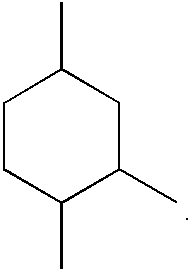Alkenyl-functional siloxane copolymers as antimisting additives for silicone coating compositions
a technology of antimisting additives and siloxane, which is applied in the direction of coatings, thin material processing, other chemical processes, etc., can solve the problems of spray mist formation, other undesirable but non-disruptive byproducts may be obtained, and the formation of spray mist is a serious problem
- Summary
- Abstract
- Description
- Claims
- Application Information
AI Technical Summary
Problems solved by technology
Method used
Image
Examples
example 2
A mixture of 90.2 g of 1,2,4-trivinylcyclohexane and 1869 g of an .alpha.,.omega.-dihydrodimethylpolysiloxane having an active hydrogen content of 0.214% by weight is activated at 25.degree. C. by adding 0.34 g of a Karstedt catalyst solution with a platinum content of 1% by weight (as described in Example 1). A temperature rise to 70.degree. C. within a few minutes indicates onset of hydrosilylation, which achieves more than 99% conversion after 15 minutes. The branched siloxane polymer with SiH end groups has an active hydrogen content of 1.19 meq / g and a viscosity of 27 mm.sup.2 / s (25.degree. C.).
In order to prepare a branched vinyl polymer, 126 g of the above-obtained SiH-functional polymer are mixed with 392 g of an .alpha.,.omega.-divinyldimethylpolysiloxane having a vinyl content of 0.67 meq / g and the mixture is heated to 47.degree. C. The addition of 10 ppm platinum in the form of the Karstedt catalyst solution (as described in Example 1) leads to an immediate temperature i...
example 3
The procedure of Example 2 is repeated with the modification that instead of the 392 g of an .alpha.,.omega.-divinyldimethylpolysiloxane having a vinyl content of 0.67 meq / g, 1089 g of the .alpha.,.omega.-divinyldimethylpolysiloxane having a chain length of 100 Si atoms (Si.sub.100) are used. This gives a branched vinyl polymer having a viscosity of 7510 mm.sup.2 / s (25.degree. C.) and a vinyl content of only 0.12 meq / g as a clear, colorless oil.
example 4
The procedure of Example 2 is repeated with the modification that instead of the 392 g of an .alpha.,.omega.-divinyldimethylpolysiloxane having a vinyl content of 0.67 meq / g, 2040 g of an .alpha.,.omega.-divinyldimethylpolysiloxane having a chain length of 163 Si atoms (Si.sub.163) are used. As a result of the increase in the chain length of the .alpha.,.omega.-divinyldimethylpolysiloxane used, the arm length of the branched vinyl polymer is increased further. The result is a clear, colorless oil having a viscosity of 11,100 mm.sup.2 / s (25.degree. C.) and a vinyl content of only 0.087 meq / g.
PUM
| Property | Measurement | Unit |
|---|---|---|
| weight percent | aaaaa | aaaaa |
| speeds | aaaaa | aaaaa |
| viscosity | aaaaa | aaaaa |
Abstract
Description
Claims
Application Information
 Login to View More
Login to View More - R&D
- Intellectual Property
- Life Sciences
- Materials
- Tech Scout
- Unparalleled Data Quality
- Higher Quality Content
- 60% Fewer Hallucinations
Browse by: Latest US Patents, China's latest patents, Technical Efficacy Thesaurus, Application Domain, Technology Topic, Popular Technical Reports.
© 2025 PatSnap. All rights reserved.Legal|Privacy policy|Modern Slavery Act Transparency Statement|Sitemap|About US| Contact US: help@patsnap.com



